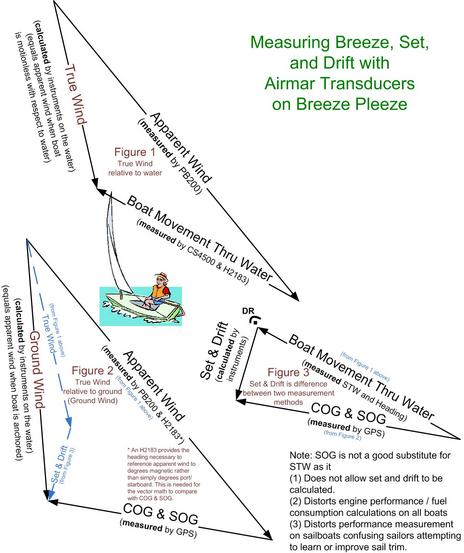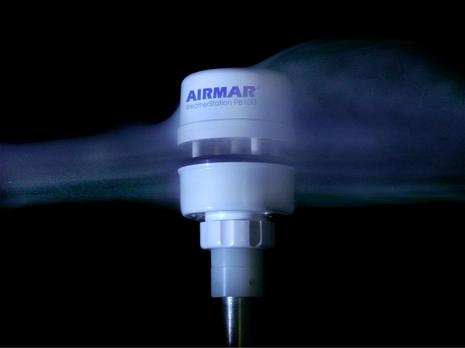Airmar CS4500 Part II (Reliable True Wind)
 In Part I of this series, Dan Corcoran, and many commenters, got into not just the value of accurate boat speed, but the true meaning of True Wind. Click on on Dan's illustration above and check out Part II...
In Part I of this series, Dan Corcoran, and many commenters, got into not just the value of accurate boat speed, but the true meaning of True Wind. Click on on Dan's illustration above and check out Part II...
In Part I, I touched upon the no maintenance nature of the CS4500 vs. the venerable paddlewheel it replaces, and the reliable boat speed measurements that result. For me, reliable means that every time I set sail, my boat speed indicator is always showing my boat speed through the water (not SOG), and the reading is consistent and not subject to how recently I performed maintenance on my speed sensor. With the CS4500, I get one other measurement reliably, and that is the display of true wind angle (TWA) and true wind speed (TWS) on my wind display and chartplotter.
(If you're a power boat owner, please note that I am referring to True Wind Relative to Water, not True Wind Relative to Earth, which we generally call Ground Wind. In fact, you can just skip to the last paragraph to learn why this True Wind could matter to you, as most of what is written below is from the sailing point of view.)
True wind readings can be anywhere between fustrating and useless on a sailboat without BOTH reliable boat speed and reliable apparent wind measurements. If you do any sailing and don't appreciate true wind, it may simply be because the true wind angle displayed is near useless.
Your apparent wind angle measurement can have errors introduced by calibration inaccuracy and very large errors from excessive mast movement. Quoting 'bobc', an expert in the area of wind measurement from a May 5th 2009 Panbo comment, "Your wind vane (mechanical apparent wind sensor, vendor name excluded here) is sailing's equivalent of a random number generator and you could reasonably expect to beat it with a damp finger held up in the air and that alone would probably be more reliable over time."
On Breeze Pleeze, I have a really good apparent wind measurement (the Airmar ultrasonic PB200) to combine with the reliable boat speed measurement of the CS4500 to determine true wind angle and speed. The reliable boat speed is really key.
* A boat speed of zero, such as from a stuck paddlewheel, prevents true wind measurement.
* A boat speed provided from your GPS (called speed over ground or SOG) will make your true wind value useless in the presence of even a � knot of current, and each time you tack your sailboat the inaccuracy will vary.
* A boat speed that varies by as little as � knot resulting from a somewhat dirty paddlewheel can introduce true wind angle errors of 10 degrees at the very low boat speeds a sailboat experiences.
Ten (10) degrees inaccuracy is a very big deal if I am trying to cross reference boat polars (documentation) that shows my fastest VMG (velocity made good) at a certain true wind speed is 45 degrees true wind. If due to inaccuracy I am steering either 35 or 55 degrees, my VMG will be cut by 50% which is saying that if my destination is upwind of my current location it will take me twice as much time to get there (that is if my crew doesn't first loose tolerance for sailing upwind and insist I start the engine).
Since it would be intolerable to take twice as long to a destination if the boat is steered 10 degrees off optimum, sailors have other methods to maximize their VMG without ever referencing true wind angle. For instance, we can look at that same documentation or just past experience, to understand what our target boat speed (speed through water) should be for a given wind speed, and know that if we are sailing at that target boat speed we are close to the desired true wind angle. But, you still need a reliable boat speed source for this method, and the method is far less precise than having the true wind angle actually displayed on your console to steer by. It's easy to believe, except for practiced racing sailors, that access to true wind angle can reduce the time to your upwind destination by 10% or more.
Stay tuned for Part III and I will close this series by discussing one method for bumping up boat speed precision just a bit more, and by extension, true wind angle precision, along with turning your CS4500 into a lean, mean, NMEA 2000 machine. There is also a Airmar H2183 solid state compass evaluation in the works that this series leads into.
I would just add, especially for the benefit of power boat owners who get very little value from true wind information, power boat and sailboat sailors can both benefit (if you have a good heading source) from obtaining an excellent ground wind angle and speed from your chartplotter, and if your chartplotter is capable, current set and drift. The ground wind angle and speed is a measurement of the wind blowing over a point on the earth as if you anchored your boat momentarily. This isn't so obvious when you're moving at 15 knots, but knowing this throughout the day and how it might have recently changed, can effect your estimates on when you might arrive at a destination and what the sea conditions will be when you do.


 Share
Share
Lucid, Dan!
But is the set and drift arrow in figure three going the wrong way? And can you not take the heading from the PB200?
{Editor: drawing fixed on 11/3/2009}